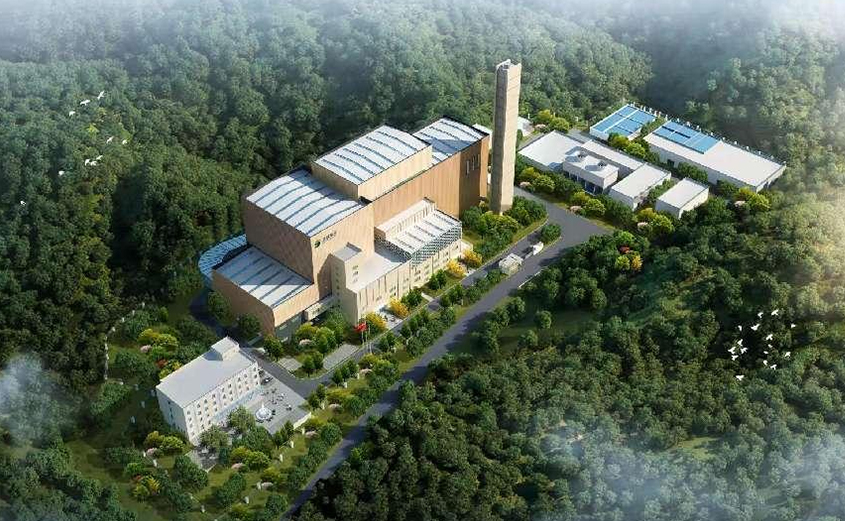Scan the QR-Code to Follow our WeChat Official
Account to Get the Latest News

Project address:Sansui SUS Renewable Energy Co.
Appointment visit contact phone number:+86 0855-4533952
The Sansui Waste-to-Energy Project situated in Qiaotou Village, Bagong Town, Sansui County, Qiandongnan Prefecture, Guizhou Province, serves as a pivotal initiative for achieving the harmless, reduction, and resource utilization of municipal solid waste across five counties within Qiandongnan Prefecture namely: Sansui County, Zhenyuan County, Tianzhu County, Jianhe County, and Cengong County. The project has a daily processing capacity of 600 tons, commenced construction on August 14, 2019, and successfully achieved grid connection for power generation on April 29, 2021.
The Sansui Waste-to-Energy PPP Project is prominently featured in the "Thirteenth Five-Year Plan" of both Guizhou Province and Qiandongnan Prefecture, highlighting is strategic importance. Garnering significant attention from the governments of Qiandongnan Prefecture, Sansui County, and other involved counties.


1. Nature Inspired De-industrialized Design
Embracing the philosophy of "de-industrialization" the project sheds the conventional perception of industrial facilities as unsightly and polluting. With a design ethos rooted in "originating from the mountains and forests, integrating into the modern," and incorporating the "honeycomb" concept, both plant layout and architectural landscape are meticulously planned. The exterior wall of the main structure is adorned with ginger yellow waterproof paint, presenting a modernized landmark image that seamlessly blends industrial aesthetics with artistic sensibilities against the backdrop of the blue sky.

2. Cutting-Edge SUS Environment Grate Technology
Equipped with SUS mechanical grate technology boasting a single furnace scale of 600 tons/day, the project ensures resilience against high temperature and corrosion, thereby ensuring prolonged service life and minimal maintenance cost.
3. Innovative Fly Ash Curing Methodology
The project adopts a stabilization process involving "fly ash, chelating agent, and water," whereby the resultant material upon meeting the water content and the output test criteria stipulated in "Pollution Control Standards for Domestic Waste Landfills," is directed to landfill sites for proper disposal.
4. Stringent Flue Gas Emission Standards
By employing a sophisticated combination process comprising SNCR (Selective Non-Catalytic Reduction) denitrification, rotary spray semi-dry deacidification, dry deacidification, activated carbon injection, and bag filter, the project surpasses national standard (GB18485-2014) for flue gas emissions.
5. Community-Centric Collaborative Initiatives
The project serves as an educational hub by featuring a waste-to-energy science propaganda column, facilitating visits from schools, local communities, enterprises, and institutions. Through various outreach activities involving over 1,300 participants the project fosters environmental awareness and education.
1. Nature Inspired De-industrialized Design
Embracing the philosophy of "de-industrialization" the project sheds the conventional perception of industrial facilities as unsightly and polluting. With a design ethos rooted in "originating from the mountains and forests, integrating into the modern," and incorporating the "honeycomb" concept, both plant layout and architectural landscape are meticulously planned. The exterior wall of the main structure is adorned with ginger yellow waterproof paint, presenting a modernized landmark image that seamlessly blends industrial aesthetics with artistic sensibilities against the backdrop of the blue sky.

2. Cutting-Edge SUS Environment Grate Technology
Equipped with SUS mechanical grate technology boasting a single furnace scale of 600 tons/day, the project ensures resilience against high temperature and corrosion, thereby ensuring prolonged service life and minimal maintenance cost.
3. Innovative Fly Ash Curing Methodology
The project adopts a stabilization process involving "fly ash, chelating agent, and water," whereby the resultant material upon meeting the water content and the output test criteria stipulated in "Pollution Control Standards for Domestic Waste Landfills," is directed to landfill sites for proper disposal.
4. Stringent Flue Gas Emission Standards
By employing a sophisticated combination process comprising SNCR (Selective Non-Catalytic Reduction) denitrification, rotary spray semi-dry deacidification, dry deacidification, activated carbon injection, and bag filter, the project surpasses national standard (GB18485-2014) for flue gas emissions.
5. Community-Centric Collaborative Initiatives
The project serves as an educational hub by featuring a waste-to-energy science propaganda column, facilitating visits from schools, local communities, enterprises, and institutions. Through various outreach activities involving over 1,300 participants the project fosters environmental awareness and education.





Scan the QR-Code to Follow our WeChat Official
Account to Get the Latest News